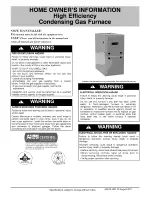
507276-03
Page 50 of 59
Issue 1621
Other Unit Adjustments
Primary Limit
The primary limit is located on the heating compartment
vestibule panel. This limit is factory set and requires no
adjustment.
Flame Rollout Switches (Two)
These manually reset switches are located on the front of
the burner box. These limits are factory set and require no
adjustment.
Pressure Switch
The pressure switch is located in the heating compartment
on the cold end header box. This switch checks for proper
combustion air inducer operation before allowing ignition
trial. The switch is factory set and must not be adjusted.
Temperature Rise
After the furnace has been started and supply and return
air temperatures have been allowed to stabilize, check the
temperature rise. If necessary, adjust the blower speed to
maintain the temperature rise within the range shown on
the unit nameplate. Increase the blower speed to decrease
the temperature. Decrease the blower speed to increase
the temperature rise. Failure to adjust the temperature rise
may cause erratic limit operation.
Fan Control
The fan ON time of 30 seconds is not adjustable. The fan
OFF delay (amount of time that the blower operates after
the heat demand has been satisfied) may be adjusted by
changing the jumper position across the five pins on the
integrated control. The unit is shipped with a factory heat
fan OFF setting of 90 seconds. The fan OFF delay affects
comfort and is adjustable to satisfy individual applications.
Adjust the fan OFF delay to achieve a supply air temperature
between 90° and 110° F at the moment that the blower is de-
energized. Longer OFF delay settings provide lower return
air temperatures; shorter settings provide higher return air
temperatures. See Figure 68.
Constant Torque Motor
These units are equipped with a constant torque ECM motor.
It has a DC motor coupled to an electronic control module
both contained in the same motor housing. The motor is
programmed to provide constant torque at each of the five
selectable speeds. The motor has five speed taps. Each
tap requires 24 volts to energize.
Thermostat Heat Anticipation
Set the heat anticipator setting (if adjustable) according to
the amp draw listed on the wiring diagram that is attached
to the unit.
Electrical
1. Check all wiring for loose connections.
2. Check for the correct voltage at the furnace (with furnace
operating).
Correct voltage is 120 VAC ± 10%
3. Check amp–draw on the blower motor with the blower
access panel in place.
Motor Nameplate__________Actual__________
Blower Speeds
Follow the steps below to change the blower speeds.
1. Turn off electrical power to furnace.
2. Remove blower access panel.
3. Disconnect existing speed tap at control board speed
terminal.
NOTE:
Termination of any unused motor leads must be
insulated.
4. Place unused blower speed tap on integrated control
“PARK” terminal or insulate.
5. Refer to blower speed selection chart on unit wiring
diagram for desired heating or cooling speed. See
Blower performance data beginning on the next page.
6. Connect selected speed tap at control board speed
terminal.
7. Re-secure blower access panel.
8. Turn on electrical power to furnace.
9. Recheck temperature rise.
Electronic Ignition
The integrated control has an added feature of an internal
Watchguard control. The feature serves as an automatic
reset device for integrated control lockout caused by ignition
failure. This type of lockout is usually due to low gas line
pressure. After one hour of continuous thermostat demand
for heat, the Watchguard will break and remake thermostat
demand to the furnace and automatically reset the integrated
control to begin the ignition sequence.
Figure 68
Summary of Contents for 95G1UHE
Page 3: ...507276 03 Page 3 of 59 Issue 1621 EXPANDED VIEW Figure 1 ...
Page 22: ...507276 03 Page 22 of 59 Issue 1621 Figure 25 Figure 26 ...
Page 28: ...507276 03 Page 28 of 59 Issue 1621 Figure 34 ...
Page 38: ...507276 03 Page 38 of 59 Issue 1621 Figure 57 Trap Drain Assembly Using 1 2 PVC or 3 4 PVC ...
Page 40: ...507276 03 Page 40 of 59 Issue 1621 Figure 59 Figure 60 ...
Page 44: ...507276 03 Page 44 of 59 Issue 1621 TYPICAL WIRING DIAGRAM Figure 65 ...
Page 57: ...507276 03 Page 57 of 59 Issue 1621 Start Up Performance Check List ...


































